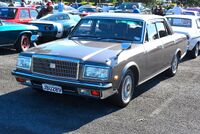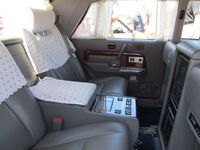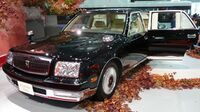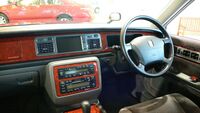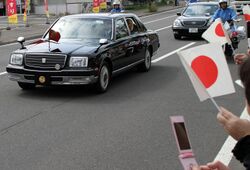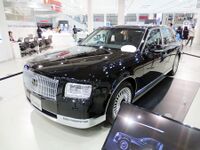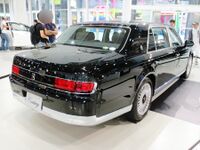Toyota Century
Topic: Engineering
 From HandWiki - Reading time: 13 min
From HandWiki - Reading time: 13 min
| Toyota Century | |
|---|---|
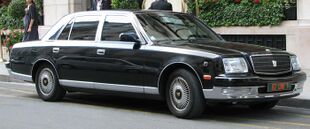 A left-hand drive Toyota Century (GZG50L) used by the Japanese Ambassador to France, with French diplomatic license plates | |
| Overview | |
| Manufacturer | Toyota |
| Production |
|
| Body and chassis | |
| Class |
|
| Body style | |
| Layout |
|
| Chronology | |
| Predecessor | Toyota Crown Eight (G10) |
The Toyota Century (Japanese: トヨタ・センチュリー Hepburn: Toyota Senchurī) is a lineup of full-size luxury cars and limousines produced mainly for the Japanese market, serving as Toyota's flagship car within Japan; globally the unrelated Lexus LS series is Toyota's flagship luxury model. Production of the Century began in 1967, and the model received only minor changes until redesigns in 1997 and 2018.
The Century derived its name from the 100th birthday of Sakichi Toyoda (born 14 February 1867), the founder of Toyota Industries. It is often used by the Imperial House of Japan, the Prime Minister of Japan, senior Japanese government leaders, and high-level executive businessmen. The Century is comparable in purpose to the Austin Princess/Daimler DS420, Cadillac Series 70, Mercedes-Maybach, Hongqi, Rolls-Royce Phantom, and Russian ZIS/ZIL limousines.
The first-generation Century was available with only a V8 engine (the third post-war Japanese-built sedan so-equipped) at its introduction in 1967 until a full platform redesign in 1997. The second generation was only installed with a Toyota-designed and -built V12, an engine bespoke to the Century, until 2018, when the power-train reverted to a V8 with the addition of Toyota's hybrid technology.
While the Century is a premium, full-size luxury sedan, it is not available at Japanese Lexus dealerships; it can only be purchased at specifically identified Toyota Store locations. The gold phoenix logo used throughout is called the Hō'ō (鳳凰) or Fushichō (不死鳥) from Sinospheric mythology, representing the Imperial House of Japan, and the image can be found throughout Asia, such as the Kinkaku-ji in Kyoto.[1]
The exterior styling of the Century has, with some modifications, remained unchanged since its introduction, primarily due to its perception as denoting conservative success. Its appearance is iconic in Asian countries and is usually painted black. The closest Japanese competitor was the Nissan President, with a similar status reputation although, during the 1960s and 1970s, the high market positioning was also shared with the Mitsubishi Debonair.[2] In the 1970s, two other Japanese competitors introduced large sedans — the Isuzu Statesman de Ville and the Mazda Roadpacer (both derived from General Motors-Australia products) — which were short-lived.
The Century nameplate introduced the SUV body style in 2023.[3]
First generation (G20/G30/G40; 1967)
| First generation | |
|---|---|
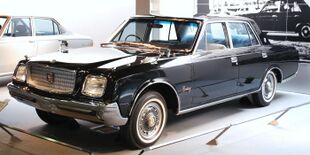 | |
| Overview | |
| Production | November 1967 – March 1997 |
| Assembly | Japan: Susono, Shizuoka (Kanto Auto Works)[4] |
| Designer | Kenya Nakamura |
| Powertrain | |
| Engine |
|
| Power output | 150–190 PS (110–140 kW) |
| Transmission | |
| Dimensions | |
| Wheelbase |
|
| Length |
|
| Width | 1,890 mm (74.4 in) |
| Height | 1,430–1,460 mm (56.3–57.5 in) |
| |uk|Kerb|Curb}} weight | 1,760–1,830 kg (3,880–4,030 lb) |
The original Century was based on the 1964 Crown Eight, which featured the 2.6 L V8 Toyota V engine, and appeared almost two years after the October 1965 introduction of the 4-liter Nissan President. The design remained largely untouched during its 30-year production run, apart from minor cosmetic changes and engine upgrades. This appearance has also inspired the designs of subsequent versions, as it remains desired by its clientele.
The 1967 Century was equipped with an upgraded version of the Crown Eight engine, the 3.0 L 3V. 1973 saw the introduction of the 3.4 L 4V, replaced by the 4V-U two years later, benefitting from the installation of emission control technology Toyota called "TTC". Only column shifters were available at first, with a manual being the base option. The manually shifted versions (Type A and Type B) were discontinued in 1973 and August 1974 respectively. The 3.4-liter V8 received fuel injection in November 1978 (4V-EU), enabling the car to meet the 1978 Emissions Standards.[6] This also meant that the chassis code was changed, to VG35.[7] The engine was once again changed to the 4.0 L 5V-EU in November 1982 (VG40), along with an all-new exterior appearance. Note that the 3V, 4V, and 5V do not refer to the number of valves in the engine but simply denote model names in the Toyota V engine range.[8] On the "C" pillar there is a badge in blue with a gothic-style "C" for Century with a label "V8" below.
In 1971, automatic climate control became available, an innovation.[9] Along with the change of engine in April 1973 (VG21) a host of other changes took place. The electromagnetic locks were changed, the taillights were changed (now with amber turn signal lenses) as well as the inclusion of front disc brakes. In September 1987, the Century received another light makeover, changing from a hydraulically operated three-speed to an electronically operated four-speed automatic transmission. A floor-mounted shifter became available on a model called the D-type, which also had front bucket seats rather than a full-width bench. The grille received detail changes and the cornering lamps were integrated into the headlight surrounds.
During Japan's Bubble Economy, sales of the Century doubled (from 1,027 in 1985 to 2,117 in 1989).[10] The Century sedan wasn't enough for those heady days, and in October 1989, the Century Limousine appeared. This was 650 mm (26 in) longer for an overall length of 5,770 mm (227.2 in), on a 3,510 mm (138.2 in) wheelbase, approximately the same dimensions as a Cadillac de Ville series, Lincoln Town Car, Mercedes-Benz S-Class, or a Rolls-Royce Silver Spirit. The Limousine also received a standard padded vinyl roof and an opera window in the centre pillar, where the stretch was placed. It also uses 150 mm wider rear doors, for a more balanced design and ease of entry. An annual production of 60 was planned.[10] As of September 1990, there was also an L-type stretched version of the Century sedan — length is 5,270 mm (207.5 in) with a wheelbase of 3,010 mm (118.5 in); this model uses the same larger rear doors as were fitted to the Century Limousine. In December 1992, the Century received its last makeover, with some very minor changes taking place in late 1994.
A Century with a GT45 gas turbine and electric motor was shown as the Century gas turbine hybrid concept vehicle at the 1975 Tokyo Motor Show.[11]
Chassis codes
- VG20: 3.0 L 3V V8, 1967–1973
- VG21: 3.4 L 4V V8, 1973–1975
- VG30: 3.4 L 4V-U V8, 1975–January 1977
- C-VG30: January 1977–November 1978 (1977 Emissions Standards)
- E-VG35: November 1978–1982[7] (1978 Emissions Standards)
- VG40: 4.0 L 5V-EU V8, 1982–1997
- VG45: 4.0 L 5V-EU V8 (L-type) 1990–1997
- First generation (G20, G30, G40)
Second generation (G50; 1997)
| Second generation | |
|---|---|
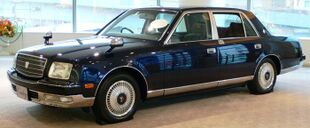 | |
| Overview | |
| Production | April 1997 – January 2017 |
| Assembly | Japan: Susono, Shizuoka (Toyota Motor East Japan)[4] |
| Designer | Akira Shimizu |
| Powertrain | |
| Engine |
|
| Power output |
|
| Transmission |
|
| Dimensions | |
| Wheelbase | 3,025 mm (119.1 in)[12] |
| Length | 5,270 mm (207 in)[12] |
| Width | 1,890 mm (74 in)[12] |
| Height | 1,475 mm (58.1 in)[12] |
| |uk|Kerb|Curb}} weight | 2,050 kg (4,520 lb)[12] |
The Century received a complete redesign in April 1997, although the new model was visually very similar to the previous generation. This model is powered by a 5.0 L 1GZ-FE V12, rated at 206 kW (276 hp; 280 PS) in Japanese models and 220 kW (295 hp; 299 PS) at 5200 rpm in export models.[citation needed] Torque was rated at 460 N⋅m (340 lbf⋅ft) at 4000 rpm for both Japanese and export versions. It was initially equipped with a 4-speed A342E automatic, until a 6-speed "intelligent" transmission arrived in 2005. It also features air suspension. The Century remains the first and only Japanese front-engine, rear-wheel-drive production car equipped with a V12, and it has Toyota's first V12 engine.[14]
This generation no longer offered a selection of level of equipment preferred, and has either a floor-mounted or column-mounted transmission selector.[15] From 2003 through 2004, the V12 engine was briefly offered with the ability to use CNG fuel.
Toyota began limited official exports of the G50 Century to Europe and other Asian markets including China and the Middle East in November 1998, positioning it as an executive car for company and government officials.[16] About 100 left-hand drive cars were produced for export, with some going to the United States for promotional and testing purposes.[17] Several were in use as corporate cars for Toyota's North American executives.[18] (As of 2023), the G50 remains the only generation of the Century sedan to have officially been exported and sold outside of Japan.[19]
The Century was Toyota's most luxurious model at its inception in 1967, and maintained this status throughout the 20th century. Today, it is positioned above the Lexus line-up, and is the most luxurious and prestigious Toyota. In contrast to other luxurious cars (such as the Maybach or Rolls-Royce), the Century has not been positioned and marketed as a sign of wealth or excess. Marketing literature states roughly that, "the Century is acquired through persistent work, the kind that is done in a plain but formal suit."[20]
Like other cars in the top of the luxury class, the Century is designed with the rear passengers in mind. Hence, the rear seats recline and the front passenger seat (in right-hand drive cars only) has a fold-down center section so that a passenger in the back may stretch their feet forward. The rear seats are equipped with a massage system. The doors are equipped with a soft-close mechanism, allowing the door to pull itself completely closed electrically when the latch makes contact with the striker.[15]
The Century was priced at ¥11,445,000 – approximately US$100,000 (equivalent to $119,172 in 2019). In comparison, the base price for the full-size luxury 2008 Lexus LS 460 is approximately ¥10,000,000 (US$87,000 (equivalent to $103,311 in 2019)),[21] with the LS 600h L at ¥15,000,000 (US$125,800 (equivalent to $149,385 in 2019)).
The second generation Century was discontinued on 4 February 2017, after almost 20 years of production.[22] 9,573 vehicles were built from 1996 (the launch year was 1997) to the final figure of 100 cars in 2016.[citation needed]
- Second generation (G50)
Century Royal (G51; 2006)
| Toyota Century Royal | |
|---|---|
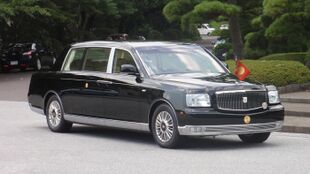 Imperial 1 | |
| Overview | |
| Production |
|
| Powertrain | |
| Engine |
|
| Transmission | 6-speed automatic (6 Super ECT) |
| Dimensions | |
| Wheelbase | 3,510 mm (138 in) |
| Length | 6,155 mm (242.3 in) |
| Width | 2,050 mm (81 in) |
| Height | 1,770 mm (70 in) |
| |uk|Kerb|Curb}} weight | 2,920 kg (6,440 lb) |
The Century Royal is the official state car currently used by the Emperor of Japan, being a specially prepared Century, a one-off ¥52,500,000 (US$500,000) custom car.[23] This special version has wool cloth upholstery, internal granite entry steps and Japanese washi rice paper headlining for the passenger compartment, as well as undisclosed security measures. The front passenger compartment is upholstered in leather.
The suspension consists of double wishbones for both the front and rear wheels, supplemented by air-bag support springs. The engine used is the 5.0 L-V12 shared with the standard Century with horsepower rated at 280 PS (206 kW; 276 bhp) and 460 N⋅m (340 lbf⋅ft) of torque at 4000 rpm.[24] For various state functions, additional conventional Century sedans are used with a designated "Imperial" number roundel.
The limousine stretches around 20 feet in length and 6.5 feet across.[25]
Chassis codes
- GZG50: 5.0 L 1GZ-FE V12
- GZG50L: 5.0 L 1GZ-FE V12 (LHD export)
- GZG50R: 5.0 L 1GZ-FE V12 (RHD export)
- GZG51: 5.0 L 1GZ-FE V12 (Century Royal)
Third generation (G60; 2018)
| Third generation | |
|---|---|
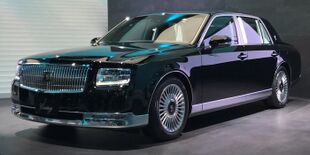 | |
| Overview | |
| Production | June 2018 – present |
| Assembly |
|
| Designer | Masato Tanabe[citation needed] |
| Body and chassis | |
| Body style |
|
| Platform | Toyota N platform[citation needed] |
| Related | Lexus LS 600h L (UVF46) |
| Powertrain | |
| Engine |
|
| Electric motor | 165 kW (221 hp; 224 PS) 1KM AC synchronous |
| Power output |
|
| Transmission | eCVT[26] |
| Hybrid drivetrain | Power-split (THS II) |
| Dimensions | |
| Wheelbase | 3,090 mm (121.7 in) |
| Length | 5,335 mm (210.0 in)[26] |
| Width | 1,930 mm (76.0 in)[26] |
| Height | 1,505 mm (59.3 in)[26] |
| |uk|Kerb|Curb}} weight | 2,370 kg (5,225 lb)[26] |
The third generation Century was unveiled at the October 2017 Tokyo Motor Show.[27] The car then went on sale on 22 June 2018, with prices starting from ¥19,600,000[26] (approximately US$180,000 at June 2018 exchange rates) to the top grade Century Limousine at ¥60,000,000.[28] The Century's production is limited to 50 per month, and it is built in a "nearly hand-made" fashion.[29] Unlike the previous generation, the G60 Century is no longer available outside of the Japanese market due to the G50's failure to sell overseas.[19]
It shows that its appearance was influenced by the Century Royal, which was produced at the request of the Japanese Imperial Household Agency to be used by senior members of the Imperial House of Japan in 2006.[30] The full model update maintains the visual tradition of the Century model, while incorporating appropriate technological upgrades and advances such as Toyota Safety Sense P-series collision avoidance support, and Toyota T-Connect.[31] The traditionally installed side-view mirrors above the front wheels, a standard feature that started with the first generation, have been replaced with door mounted units, incorporating turn signal lights.
As with previous generations, rear passenger comfort and convenience is made a priority. The rear seats have a recline feature, with integrated heaters and massage function, as well as an adjustable power leg rest for the rear seat opposite the driver. The sound system comes standard with 20 speakers. A 20-inch LCD screen is installed for rear seat passengers that let occupants control many aspects and features as a convenience as well as playing video content. The standard upholstery fabric continues to be offered in three color choices using 100% wool with a unique heather pattern, with leather remaining available optionally in two different color combinations. Both upholstery choices include two different wood inlay selections. The transmission selector, which on previous generations was either floor mounted or steering column installed, is now only available on the floor.
The powertrain is Hybrid Synergy Drive including the 2UR-FSE 5.0-litre V8 petrol engine, maintaining the displacement of the prior V12 engine but adding an electric drive system for fuel economy improvement to 13.6 km/L (7.4 L/100 km; 38 mpg‑imp; 32 mpg‑US), compared to the prior generation's 10 km/L (10 L/100 km; 28 mpg‑imp; 24 mpg‑US). The powertrain package is the same as the 2008-2017 Lexus LS 600h & LS 600h L; however, as the fifth-generation LS does not feature this powertrain, it is now unique to the Century.[32] The suspension has been upgraded from the previous double wishbone to a multi-link suspension with supplemental air bags to further enhance ride quality. Toyota first displayed a hybrid engine in the Century at the 1975 Tokyo Motor Show in the Century gas turbine hybrid, with a GT45 gas turbine and electric motor.[11]
Chassis codes
- UWG60: 5.0 L 2UR-FSE V8[26]
Production transfer
From 1967 to 2020, the Century was assembled at the Higashi-Fuji plant (Susono, Shizuoka) owned by Kanto Auto Works and its successor Toyota Motor East Japan. On 10 December 2020, Toyota Motor East Japan ceased car production at Higashi-Fuji. Toyota moved the Century assembly operations to Toyota City's Motomachi plant.[33][34]
- Third generation (G60)
Century SUV (G70; 2023)
| SUV | |
|---|---|
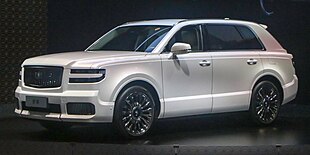 Century SUV (GRG75L, China) | |
| Overview | |
| Production | September 2023 – present[35] |
| Assembly | Japan: Tahara, Aichi (Tahara plant)[3] |
| Designer | |
| Body and chassis | |
| Class | Full-size luxury crossover SUV |
| Body style | 5-door SUV |
| Layout | Transverse front-engine, four-wheel-drive (E-Four Advanced) |
| Platform | TNGA: GA-K |
| Related | |
| Powertrain | |
| Engine |
|
| Electric motor |
|
| Power output |
|
| Transmission | eCVT |
| Hybrid drivetrain | Plug-in |
| Battery | 51-Ah lithium-ion |
| Electric range | 69 km (43 mi) |
| Dimensions | |
| Wheelbase | 2,950 mm (116.1 in) |
| Length | 5,205 mm (204.9 in) |
| Width | 1,990 mm (78.3 in) |
| Height | 1,805 mm (71.1 in) |
| uk|uk|Kerb|Curb}} weight | 2,570 kg (5,666 lb) |
The Century-badged SUV model was unveiled on 6 September 2023.[3] It is built on the front-wheel drive-based GA-K platform shared with the North American market Grand Highlander and the Lexus TX. A 3.5-litre 2GR-FXS V6 engine with plug-in hybrid drivetrain is standard.
Development was led by Yoshikazu Tanaka as chief engineer, along with Design Division General Manager Tatsuya Sonoda.[37] In its marketing materials and official releases, Toyota avoided the 'SUV' label to the vehicle. The company described it simply as the "New Century", and according to Tanaka, a "new concept for chauffeur-driven mobility." He explained that the G75 Century adopts this body style to maximise backseat space.[38][39]
Markets
Japan
The Century SUV launched in Japan on 6 September 2023, with orders beginning the same day.[3] In Japan, the SUV is sold alongside the G60 sedan at select Toyota dealerships employing specialized sales and service staff called "Century Meisters".[3]
China
The Chinese-market version of the Century SUV was introduced at Auto Guangzhou 2023 on 17 November 2023.[40] Slated to be sold through the Lexus dealer network as an imported model, it is the first Century model to officially be exported and sold outside of Japan with a left-hand drive configuration since the G50 sedan, which was discontinued in 2017.[41]
Chassis codes
- GRG75: 3.5 L 2GR-FXS V6 (Japan)
- GRG75L: 3.5 L 2GR-FXS V6 (LHD, China)[41]
See also
References
- ↑ Schumacher, Mark (2011-08-27). "Hou-ou (or Hoo-oo)—the Japanese Phoenix". http://www.onmarkproductions.com/html/ho-oo-phoenix.shtml.
- ↑ "Mitsubishi Automotive History" (Press release). South Africa: Mitsubishi. Archived from the original on 2008-09-22. Retrieved 2013-05-21.
- ↑ 3.0 3.1 3.2 3.3 3.4 3.5 "Toyota to Launch New Century in Japan". Toyota Motor Corporation Official Global Website (Press release). 2023-09-06. Retrieved 2023-09-06.
- ↑ 4.0 4.1 "Affiliates (Toyota wholly-owned subsidiaries)-Toyota Motor East Japan, Inc.". Toyota. 2012. http://www.toyota-global.com/company/history_of_toyota/75years/data/automotive_business/production/production/japan/general_status/toyota_motor_east_japan.html.
- ↑ Toyota Century, Japanese sales brochure, circa 1990
- ↑ (in ja) 自動車ガイドブック, 26, Japan: Japan Automobile Manufacturers Association, 1979-11-01, p. 113, 053-790026-3400
- ↑ 7.0 7.1 Automobile Guide Book 1979/1980, p. 118
- ↑ "トヨタ センチュリー | 世代別モデル一覧". Toyota. http://gazoo.com/car/database/Pages/generation_list.aspx?MAKER_CD=A&CARTYPE_CD=010.
- ↑ "75 Years of Toyota - Technical Development - Electronics Parts". Toyota. 2012. http://www.toyota-global.com/company/history_of_toyota/75years/data/automotive_business/products_technology/technology_development/electronics_parts/index.html.
- ↑ 10.0 10.1 Tazawa (田澤), Kōichi (晃一), ed (1997) (in ja). 絶版車カタログ 国産車編 Part5 1980~1989. Eichi Mook. Tokyo: Eichi Publishing (英知出版). p. 5. ISBN 4-7542-5120-2.
- ↑ 11.0 11.1 Toyota brochure from the 1975 Tokyo Motor Show (Japanese)
- ↑ 12.0 12.1 12.2 12.3 12.4 (in Japanese) Century sales brochure. Japan: Toyota. January 2005.
- ↑ Toyota Century (second generation), Japanese sales brochure, #TB0018-0105 (2001)
- ↑ "75 Years of TOYOTA". Toyota. 2012. http://www.toyota-global.com/company/history_of_toyota/75years/data/automotive_business/products_technology/technology_development/engines/index.html.
- ↑ 15.0 15.1 "Toyota Century Catalog". Proto Corporation. http://www.goo-net.com/catalog/TOYOTA/CENTURY/index.html.
- ↑ "Toyota to Begin Century Saloon Exports" (Press release). Toyota. 1998-10-15. Retrieved 2021-03-22.
- ↑ Mihori, Naotsugu. "トヨタ自動車 製品企画本部 センチュリー 開発主査 清水 勉 インタビュー(5/5)|NEXTALK【オートックワン】" (in ja-JP). オートックワン. https://autoc-one.jp/toyota/century/special-1120901/0005.html.
- ↑ Motavalli, Jim (2005-01-30). "What the Heck Was That Crazy Car?". The New York Times (US). https://www.nytimes.com/2005/01/30/automobiles/what-the-heck-was-that-crazy-car.html.
- ↑ 19.0 19.1 Lieberman, Jonny (2019-02-26). "Inside Look: How the Toyota Century Rivals Rolls-Royce". Motor Trend. https://www.motortrend.com/features/we-dont-get-it/.
- ↑ "Perpetual Classic: 2013 Toyota Century: The Ultimate Brougham Time Machine". Curbside Classic. 2013-05-20. http://www.curbsideclassic.com/curbside-classics-asian/perpetual-classic-2013-toyota-century-the-ultimate-brougham-timemachine.
- ↑ Schreffler, Roger; Chrysler, Mack (2006-12-28). "Lexus Slowly Progressing in Japan". WardsAuto. http://wardsdealer.com/latest/lexus_progressing_japan.
- ↑ Hsu, Ben (2017-10-05). "NEWS: Toyota will introduce a new Century for only the third time in 50 years". Japanese Nostalgic Car. http://japanesenostalgiccar.com/3rd-generation-toyota-century/#more-61776.
- ↑ "Goryō new vehicles - the Imperial Household Management Division" (in ja). 2006-07-12. http://www.kunaicho.go.jp/kunaicho/koho/kohyo/goryosha.html.
- ↑ "センチュリー フロアシフト(2014年4月) のカタログ情報". Proto. http://www.goo-net.com/catalog/TOYOTA/CENTURY/10088800/index.html.
- ↑ "Toyota gives emperor the Century Royal treatment". Windingroad.com. 2006-07-13. http://www.nextautos.com/auto-news/toyota-gives-emperor-the-century-royal-treatment.
- ↑ 26.0 26.1 26.2 26.3 26.4 26.5 26.6 "TOYOTA CENTURY catalog - reviews, pics, specs and prices". Goo-net Exchange. Japan. 2018. http://www.goo-net-exchange.com/catalog/TOYOTA__CENTURY/.
- ↑ "Toyota to Debut Next-generation Century at Tokyo Motor Show 2017" (Press release). Toyota Motor Corporation. 2017-10-05. Retrieved 2017-10-27.
- ↑ (in ja). Japan. 2018-03-18. https://car.kurumagt.com/2017-fs.html.
- ↑ Saito, Ken (2019-07-24). "The Most Interesting Car Toyota Makes Is Too Luxurious for America". Jalopnik. https://jalopnik.com/the-most-interesting-car-toyota-makes-is-too-luxurious-1836026347.
- ↑ "2018 Toyota Century". Net Car Show. https://www.netcarshow.com/toyota/2018-century/.
- ↑ Toyota's Rolls-Royce for half the money - the incredible 2018 Century. 2017-10-27. Archived from the original on 2021-12-12. Retrieved 2017-10-28 – via YouTube.
- ↑ Hsu, Ben (2017-10-05). "NEWS: Toyota will introduce a new Century for only the third time in 50 years". Japanese Nostalgic Car. http://japanesenostalgiccar.com/3rd-generation-toyota-century/#more-61776.
- ↑ "トヨタ東日本、東富士工場の生産終了 東北に集約、小型車強化へ". Kahoku Shimpo. 2020-12-11. https://sp.kahoku.co.jp/amp/tohokunews/202012/20201211_12004.html.
- ↑ Yabuki, Takafumi; Wada, Shota (2020-12-30). "センチュリーもヨタハチも トヨタ東富士工場、生産に幕". Asahi Shimbun. https://www.asahi.com/amp/articles/ASNDX4358NDLUTPB017.html.
- ↑ "トヨタ 取扱説明書 センチュリー" (in ja-JP). Toyota. https://manual.toyota.jp/century/.
- ↑ 36.0 36.1 "Century Design Sketches". Toyota. 2023-09-06. https://global.toyota/en/mobility/toyota-brand/toyota-design/century/.
- ↑ "This is No SUV—Developer's Vision Behind the New Century". Toyota Times (Press release). Retrieved 2023-12-02.
- ↑ "Toyota to Launch New Century in Japan". Toyota Motor Corporation Official Global Website (Press release). 2023-09-06. Retrieved 2023-12-02.
- ↑ Sergeev, Angel (2023-10-09). "Toyota Says The New Century Is Not An SUV". Motor1 (US). https://www.motor1.com/news/690460/toyota-century-not-suv/.
- ↑ "近130余款新车 2023广州车展最全汇总" (in zh). Autohome, Inc. (China). 2023-11-17. https://www.autohome.com.cn/news/202311/1290734.html.
- ↑ 41.0 41.1 "トヨタが新型SUV「世極」発表! 白ボディで塊感強調!? 全長5m超えの新たな「センチュリー」を中国でお披露目" (in ja). Motor Vehicle News. 2023-11-18. https://kuruma-news.jp/post/713026/2.
External links
- Toyota concept cars
- 1975 Tokyo Motor Show
- Century Royal in an Escorted Convoy
- Another view of the Century Royal in another Escorted Convoy
 |
 KSF
KSF

